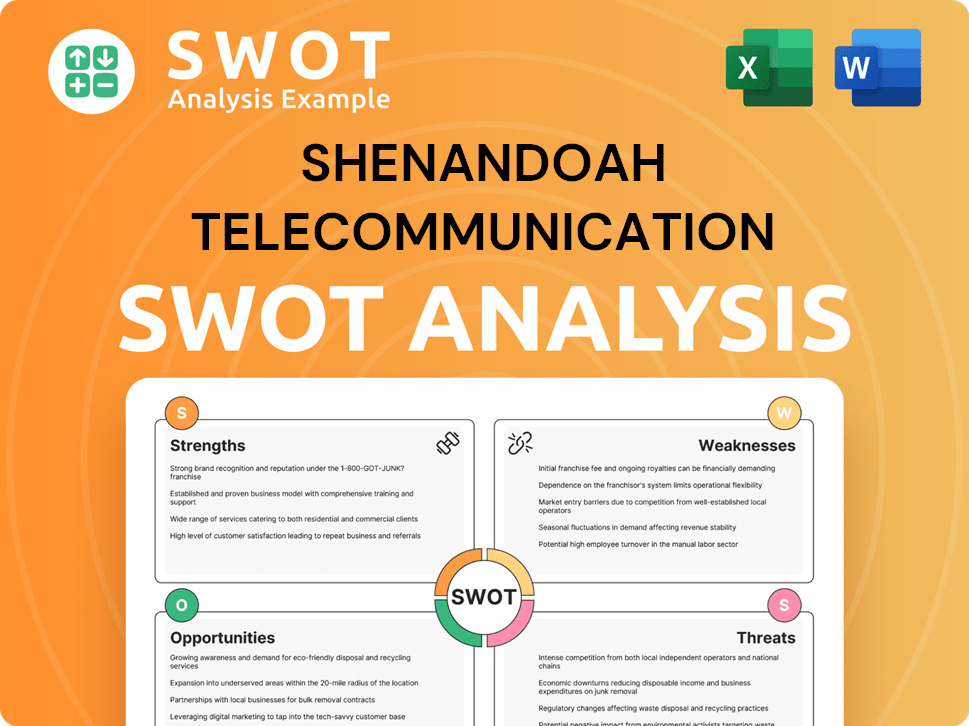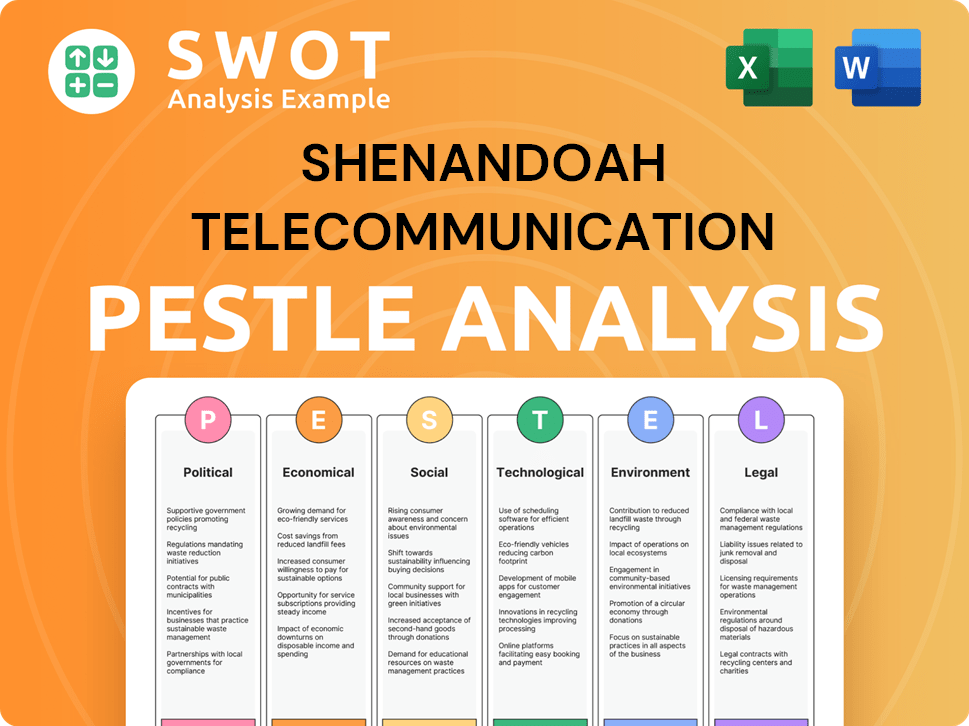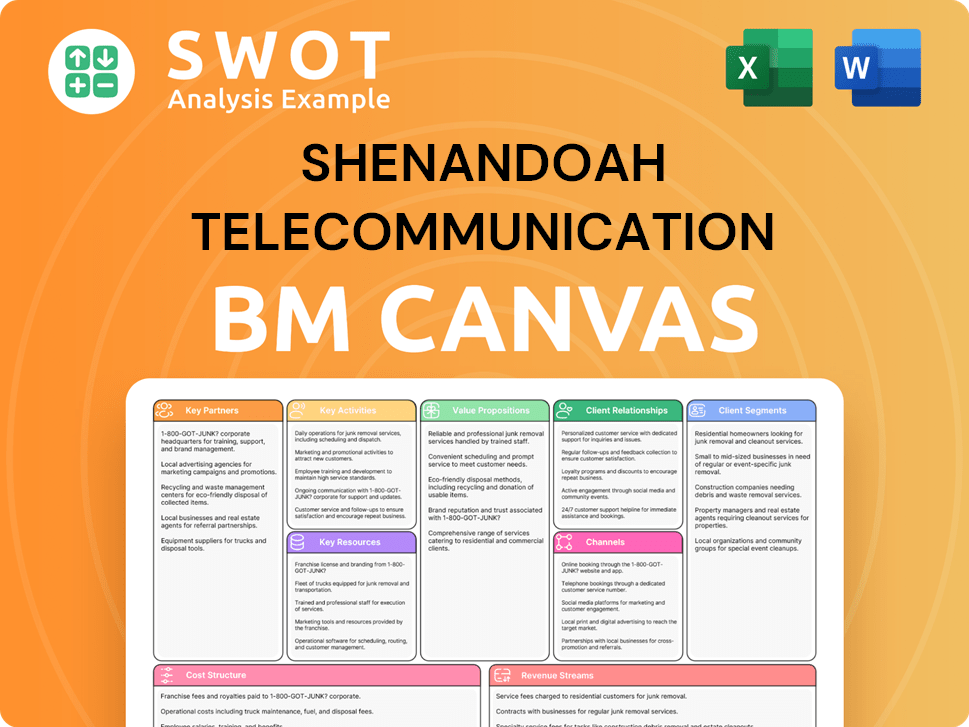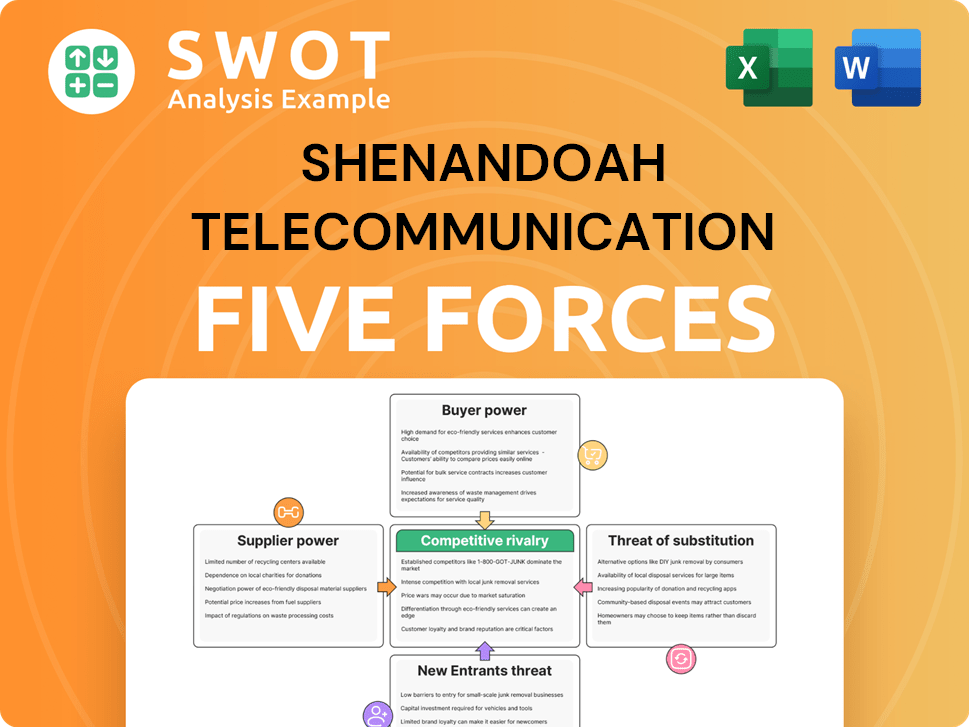Shenandoah Telecommunication Bundle
Can Shentel Conquer the Telecommunications Landscape?
Shenandoah Telecommunications Company (Shentel) is rapidly expanding its fiber optic broadband services, making waves in the Mid-Atlantic region. With impressive growth in its Glo Fiber product, Shentel is proving its ability to capture market share. This article delves into the inner workings of this Shenandoah Telecommunication SWOT Analysis, exploring its strategic moves and financial performance.

As a leading internet service provider, Shentel's aggressive expansion and strategic acquisitions are reshaping the telecommunications industry. Understanding Shentel's operational model is crucial for anyone interested in the broadband services market. We'll explore Shentel's financial results and the implications for both investors and customers, including insights into Shentel internet plans and pricing, and how it stacks up against other cable company competitors.
What Are the Key Operations Driving Shenandoah Telecommunication’s Success?
The core operations of Shenandoah Telecommunications, often referred to as Shentel, revolve around providing broadband services, including high-speed internet, video, and voice solutions to both residential and commercial clients. This cable company leverages its extensive fiber optic and cable networks, which span over 16,800 route miles across eight eastern U.S. states. A key focus is the expansion of its fiber-to-the-home (FTTH) service, branded as Glo Fiber.
Shentel's value proposition centers on delivering superior connectivity and customer service, especially in areas where high-quality broadband options are limited. The company's commitment to symmetrical upload and download speeds, up to 5 gigabits per second (Gbps) with Glo Fiber, underscores its investment in advanced technology. This approach, coupled with a focus on low latency and local customer support, differentiates Shentel within the telecommunications industry.
In Q1 2025, Glo Fiber Expansion Markets added 5,400 new subscribers and 16,600 new passings, demonstrating a rapid deployment strategy. The company aims to reach 440,000 Glo Fiber passings by the end of 2025 and 550,000 by the end of 2026, targeting over 800,000 broadband passings when combined with its Incumbent Broadband Markets.
Shentel's extensive fiber optic and cable networks are the backbone of its operations. These networks allow Shentel to provide high-speed internet and other services. The company continues to invest in expanding its fiber network to reach more customers.
Shentel offers a range of services, including high-speed internet, video, and voice. Its Glo Fiber service provides symmetrical speeds up to 5 Gbps. The company focuses on providing reliable and high-quality services to both residential and commercial customers.
Shentel emphasizes local customer service and support. This focus helps to differentiate the company from competitors. Shentel aims to provide a superior customer experience, particularly in rural and underserved areas.
Shentel's strategic partnerships and acquisitions, such as the Horizon Telcom integration in 2024, have expanded its footprint. These partnerships are crucial for increasing its market reach and enhancing its service offerings. This has contributed to significant revenue growth.
Shentel distinguishes itself through several key factors, including its advanced fiber-to-the-home technology and commitment to customer service. These elements contribute to a superior customer experience.
- High-speed internet with symmetrical upload and download speeds.
- Focus on low latency for improved performance.
- Local customer service and support.
- Strategic expansion into new markets.
For more information about the company's history and development, you can read Brief History of Shenandoah Telecommunication.
Shenandoah Telecommunication SWOT Analysis
- Complete SWOT Breakdown
- Fully Customizable
- Editable in Excel & Word
- Professional Formatting
- Investor-Ready Format

How Does Shenandoah Telecommunication Make Money?
The primary revenue streams for Shenandoah Telecommunications (Shentel) come from its broadband services, which include high-speed internet, video, and voice offerings for both residential and commercial clients. While the company previously generated revenue from tower colocation services, its tower business was sold in March 2024.
In Q1 2025, Shentel's total revenue reached $87.9 million, marking a significant increase of 26.9% compared to the same period in 2024. This growth was largely fueled by the acquisition of Horizon markets, which contributed $15.2 million in revenue during Q1 2025. Excluding the impact of the Horizon acquisition, Shentel still achieved a solid revenue increase of 5% to $72.9 million.
A substantial portion of Shentel's revenue growth is attributed to its Glo Fiber Expansion Markets, which saw a remarkable 52% increase in revenue, reaching $18.4 million in Q1 2025. The Commercial Fiber segment also demonstrated strong performance, nearly doubling its revenue year-over-year, from $9.9 million to $19.6 million in Q1 2025. This demonstrates the company's strong position in the telecommunications industry.
Shentel employs several monetization strategies to maximize its revenue potential. These include tiered pricing structures for its broadband services, offering symmetrical upload and download speeds up to 5 Gbps. The company also utilizes bundled services that combine internet, video, and phone options to attract and retain customers.
- The Incumbent Broadband Markets revenue remained relatively flat at $43.4 million in Q1 2025, experiencing a 5% decline, primarily due to a decrease in video revenue generating units (RGUs) and lower data revenue.
- For the full year 2024, total revenue increased by 21.9% to $328.1 million, with Glo Fiber Expansion Markets revenue growing by 65% to $57.9 million.
- Shentel's commercial fiber revenue faced challenges due to T-Mobile backhaul circuit disconnects as part of the decommissioning of the former Sprint network, which impacted 2024 revenue. However, the company anticipates a return to mid to high single-digit growth rates in commercial fiber revenue starting in 2025.
- The company also benefits from government grant cash reimbursements, totaling $6.9 million in Q1 2025, which supports its network expansion efforts. To learn more about the company's financial performance, you can read about Owners & Shareholders of Shenandoah Telecommunication.
Shenandoah Telecommunication PESTLE Analysis
- Covers All 6 PESTLE Categories
- No Research Needed – Save Hours of Work
- Built by Experts, Trusted by Consultants
- Instant Download, Ready to Use
- 100% Editable, Fully Customizable

Which Strategic Decisions Have Shaped Shenandoah Telecommunication’s Business Model?
The evolution of Shenandoah Telecommunications (Shentel) has been marked by significant milestones and strategic initiatives that have reshaped its operational and financial landscape. A pivotal move was the acquisition of Horizon Telcom in April 2024, which expanded Shentel's reach into Ohio and was fully integrated by the fourth quarter of 2024. This strategic acquisition, coupled with aggressive fiber network expansion, highlights Shentel's commitment to growth and enhanced service delivery.
Shentel's strategic focus on expanding its fiber optic network, branded as Glo Fiber, has been a primary driver of revenue growth. The company has also actively pursued government grant funding to support broadband expansion in underserved areas. Despite facing challenges such as T-Mobile revenue churn and declines in incumbent broadband revenue, Shentel's competitive edge lies in its advanced fiber optic infrastructure and commitment to customer service.
The company's integrated network strategy, combining fiber and cable broadband, along with its aggressive build-out plans and strategic acquisitions, positions it to adapt to evolving technological shifts and competitive threats. For more insights into their growth trajectory, consider reading about the Growth Strategy of Shenandoah Telecommunication.
The acquisition of Horizon Telcom in April 2024 was a key milestone, expanding Shentel's footprint, with full integration by Q4 2024. This acquisition contributed $15.2 million to revenue in Q1 2025. Shentel added approximately 103,000 new fiber passings in 2024, bringing the total to over 346,000.
Aggressive expansion of the Glo Fiber network is a central strategic move. Shentel aims for 440,000 Glo Fiber passings by the end of 2025 and 550,000 by the end of 2026. The company actively pursued government grant funding, receiving approximately $19 million in reimbursements in 2024 and $6.9 million in Q1 2025.
Shentel's competitive advantage lies in its state-of-the-art fiber optic network, offering multi-gigabit speeds. The company focuses on superior local customer service. Shentel's integrated network strategy, combining fiber and cable broadband, and its aggressive build-out plans support its competitive position in the telecommunications industry.
The Horizon Telcom acquisition is expected to yield annual run-rate synergy savings of $13.8 million by Q2 2025, exceeding original projections. Glo Fiber Expansion Markets revenue increased by 52% in Q1 2025. Shentel continues to invest in its network, which is a key factor in its long-term success as an internet service provider.
Shentel has faced challenges such as T-Mobile revenue churn and declines in incumbent broadband revenue. The company is adapting to evolving technological shifts and competitive threats through its integrated network strategy and expansion plans. The focus on fiber optic internet availability and customer service will be crucial for future growth.
- T-Mobile revenue churn due to Sprint network decommissioning.
- Decline in incumbent broadband market revenue.
- Focus on expanding fiber optic network and customer service.
- Strategic acquisitions and government funding to support growth.
Shenandoah Telecommunication Business Model Canvas
- Complete 9-Block Business Model Canvas
- Effortlessly Communicate Your Business Strategy
- Investor-Ready BMC Format
- 100% Editable and Customizable
- Clear and Structured Layout

How Is Shenandoah Telecommunication Positioning Itself for Continued Success?
In the competitive telecommunications industry, Shenandoah Telecommunications (Shentel) holds a significant position, especially in the Mid-Atlantic region. The company provides comprehensive broadband services across eight eastern U.S. states. Its strategy focuses on expanding its fiber footprint, aiming for substantial growth in broadband passings by 2026, combining its Glo Fiber and Incumbent Broadband Markets.
Shentel faces several risks and headwinds. These include high capital expenditures for network expansion, competitive pressures from cable and fiber providers, and the impact of regulatory changes. Despite these challenges, Shentel is focused on achieving free cash flow growth and expanding its fiber network.
Shentel operates as a key internet service provider in the Mid-Atlantic region, focusing on broadband services. It is actively expanding its fiber network, with a goal of over 800,000 broadband passings by 2026. The company competes with other providers in the telecommunications industry, including cable companies and other fiber optic services.
Key risks involve high capital expenditures needed for network expansion, which resulted in a net loss of $9.1 million in Q1 2025. Competitive pressures are also significant, with approximately 28% of passings facing competition. Regulatory changes, like the end of the Affordable Connectivity Program, also impact revenue.
Shentel's future is centered on expanding its Glo Fiber network and achieving free cash flow growth. Management projects that Glo Fiber expansion markets will become its largest line of business by customers by 2026 and by revenue by 2029. The company plans to add over 100,000 fiber passings in each of the next two years.
In Q1 2025, Glo Fiber Expansion Markets saw a 51% increase in data subscribers, reaching approximately 71,000. The company reported a low monthly broadband data churn rate of 0.9% and a net promoter score of 69 for Glo Fiber. Shentel projects capital spending of $250 million to $280 million for the full year 2025.
Shentel's strategic plans include expanding its Glo Fiber network and achieving free cash flow growth. The company aims to add over 100,000 fiber passings annually for the next two years. Shentel is also focused on refinancing credit facilities and extending debt maturities to reduce interest expenses.
- Expanding Glo Fiber network to increase broadband availability.
- Refinancing credit facilities to reduce interest expenses.
- Strategic acquisitions to sustain and expand revenue generation.
- Focusing on free cash flow growth from mature markets.
Shenandoah Telecommunication Porter's Five Forces Analysis
- Covers All 5 Competitive Forces in Detail
- Structured for Consultants, Students, and Founders
- 100% Editable in Microsoft Word & Excel
- Instant Digital Download – Use Immediately
- Compatible with Mac & PC – Fully Unlocked

Related Blogs
- What are Mission Vision & Core Values of Shenandoah Telecommunication Company?
- What is Competitive Landscape of Shenandoah Telecommunication Company?
- What is Growth Strategy and Future Prospects of Shenandoah Telecommunication Company?
- What is Sales and Marketing Strategy of Shenandoah Telecommunication Company?
- What is Brief History of Shenandoah Telecommunication Company?
- Who Owns Shenandoah Telecommunication Company?
- What is Customer Demographics and Target Market of Shenandoah Telecommunication Company?
Disclaimer
All information, articles, and product details provided on this website are for general informational and educational purposes only. We do not claim any ownership over, nor do we intend to infringe upon, any trademarks, copyrights, logos, brand names, or other intellectual property mentioned or depicted on this site. Such intellectual property remains the property of its respective owners, and any references here are made solely for identification or informational purposes, without implying any affiliation, endorsement, or partnership.
We make no representations or warranties, express or implied, regarding the accuracy, completeness, or suitability of any content or products presented. Nothing on this website should be construed as legal, tax, investment, financial, medical, or other professional advice. In addition, no part of this site—including articles or product references—constitutes a solicitation, recommendation, endorsement, advertisement, or offer to buy or sell any securities, franchises, or other financial instruments, particularly in jurisdictions where such activity would be unlawful.
All content is of a general nature and may not address the specific circumstances of any individual or entity. It is not a substitute for professional advice or services. Any actions you take based on the information provided here are strictly at your own risk. You accept full responsibility for any decisions or outcomes arising from your use of this website and agree to release us from any liability in connection with your use of, or reliance upon, the content or products found herein.